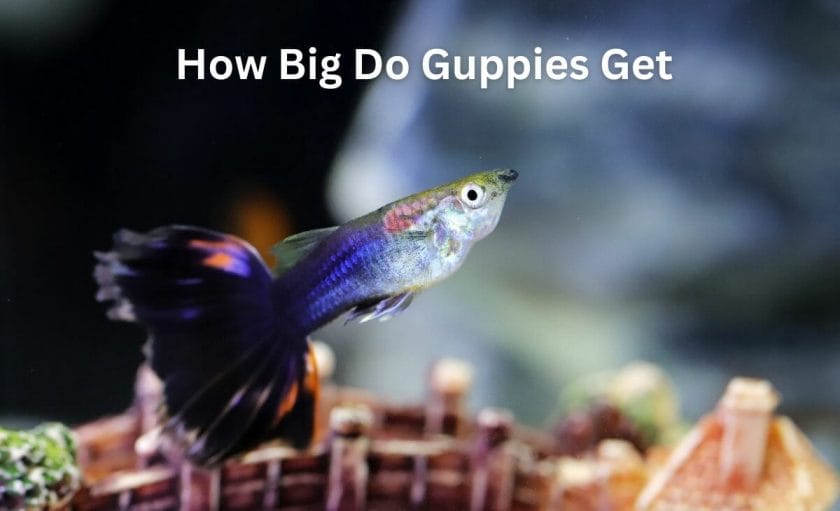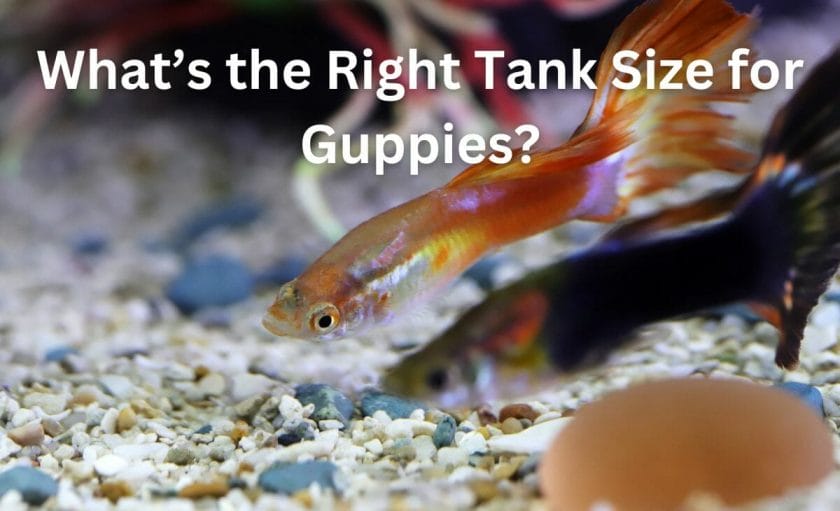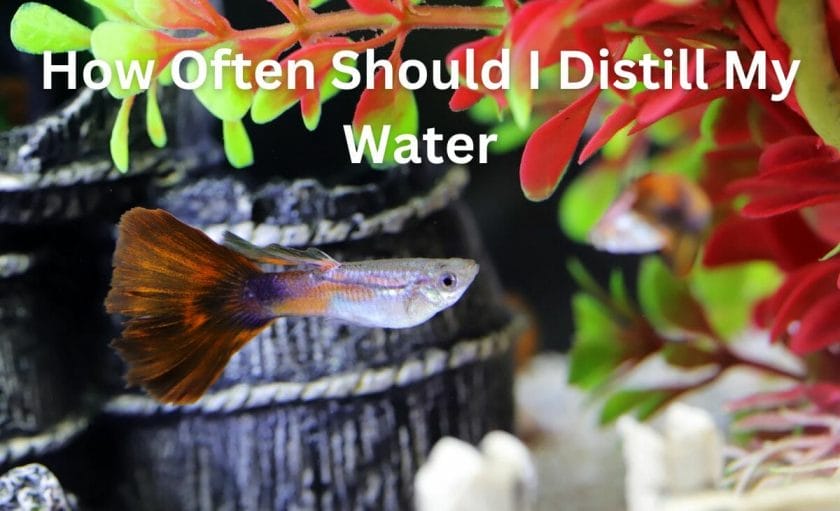Guppies are a great fit for most community tanks. Small, colorful, and vibrant, they’re entertaining to watch and easy to keep. But whether you’re going for a nano tank or a larger community tank, you’ll need to know how big they get.
Guppies can be anywhere from 0.5 inches to 2 inches. Newly born, they are only a quarter inch in length and will reach their full size after six months.
The perfect starter fish, guppies have a lot going for them, but small as it may seem, their size is something to be considered in your tank.
Read on, because I’m going to explore how big different species of guppies get and why it’s important.
I’ll also share some of my personal experiences keeping guppies and why they’re worth considering for your tank.

Table of Contents
How Big Do Guppies Get?

Guppies generally range anywhere from 1.5 to 2.5 inches, although sizes may vary depending on genetics, environment, and other factors.
There are three main factors that determine the size of a guppy: gender, species, and environment. Guppies reach their maximum size after 6 months, and, of course, a younger guppy will be smaller than an adult guppy.
Guppies go through the following life stages:
- Fry
- Juvenile
- Young
- Adult
In the first three stages, guppies will continue to grow. At the juvenile stage, guppies start to develop their colors at about 1 month of age.
When they reach young adulthood at 2 months, they become sexually mature and will divert their attention between breeding and feeding.
Here’s a helpful chart that determines how big a guppy is likely to be based on its age.
| Age | Size |
| 1 month | ¼ inch |
| 2 months | ½ – ⅔ inches |
| 6 months | 1.5 – 2.5 inches |
Gender
Guppies exhibit significant sexual dimorphism and are easily distinguished by coloration and size. The males tend to be a little smaller and have bright, flowing fins.
The females are larger and tend to be a little plumper. In fact, they can grow to be twice the size of the males! Both can exhibit flowy tails, but due to the males’ smaller size, their tails tend to be more noticeable.
Males might peak at just under the 2 inch mark, while females can peak at 2.5 inches.
Species
Different species of guppies have slight variations in how big they get. For example, the Scarlet Livebearer only reaches 1.2 inches, while the Fancy Guppy can reach up to 2.5 inches.
Genetics are also important, although as an aquarist, you can’t change the genetics of an individual guppy. A guppy may have a deformity that stunts its growth, such as having a fusion in the spine.
The difference in size for different species of guppies raises an important point: always source your fish from a reputable pet shop; otherwise, you may end up with a species that grows much bigger than you think.
You might also not get the coloration you’re looking for, although there can be great variation in coloration contained in one species.
Tank Environment
A well-established tank is beneficial for guppies, while a cramped tank with poor water quality can stunt guppy growth. Inadequate space can cause underdeveloped muscles, impacting a fish’s physical growth.
Similarly, the chemical conditions in the tank, like temperature and pH, can affect the growth of a fish. Fish, including guppies, are highly sensitive to changes in these parameters and can be stressed by changes in the environment.
This stress creates a hormone feedback loop that, over time, can affect your fish’s growth, immune system function, and reproductive capabilities.
What’s the Right Tank Size for Guppies?

A 5-gallon tank is the minimum tank size to keep guppies. In fact, a 5-gallon tank is the minimum I would recommend for any fish tank. Period.
Any tank that’s smaller is immediately problematic, regardless of the fish species. That’s because it’s extremely difficult to maintain a stable nitrogen cycle in a tank that’s smaller.
Nano tanks, which focus on aquariums with smaller species and fewer fish, are popular because they have a smaller impact, require less maintenance, and are more portable than their larger counterparts. Still, they’re not easier in every regard.
It’s important to stick to the 1 inch per fish rule. While this rule is useful, it’s not hard and fast. You should test regularly using a test kit.
You should also be mindful not to overfeed the tank. If there’s leftover food more than 30 minutes after feeding time, feed less.
Moreover, you should carefully monitor your tank for signs of overstocking, which may include:
- Fish gasping due to a lack of oxygen
- Overabundance of algae
- Unusual fish behavior
- Heightened aggression
- Lethargy
- Cloudy water even after cleaning
Guppies also need to be kept in a group of 5-8 to spread out aggression, and you may need to keep the males and females separated in different tanks.
Guppies are livebearers that breed prolifically, and without any natural predators, a tank’s guppy population will only grow. The guppies do cannibalize their young, but it’s important to start with a 10 gallon tank.
How Many Guppies Can You Keep in a 5-Gallon Tank?
In general, you can keep 3-5 guppies in a 5-gallon tank. Remember, you should be keeping 1 male for every 2 females to help spread out sexual aggression. That, or you can keep the males and females separately, which is probably preferable in a smaller tank where the females have fewer places to hide.
How Many Guppies Can You Keep in a 10-Gallon Tank?
You can feasibly house 5-7 guppies in a 10-gallon tank. Again, it’s important to keep the males and females paired at a 1:2 ratio to reduce bullying and aggression on any one female. You can easily pick out males and females by their characteristics to ensure you’re setting up your tank properly.
How to Grow Guppies to Full Size

There are several factors that can help or harm a guppy’s chance of growing to full size. Some of these are actionable steps that an aquarist can take to improve their quality of life. Of course, at 6 months of age, guppies will stop growing.
Still, the following suggestions are important not only to help your guppies grow, but also to improve their quality of life in the long run.
Providing a Safe Environment
The right sized tank is a good start to help your guppies grow to their full potential. Plants, as always, are king. Leaves and grass provide safety for guppies and reduce stress. Sand is an ideal substrate and has the added benefit of making plant colors pop.
Again, I can’t stress enough that guppies are really mean towards one another. The males chase the females relentlessly and will scrap with one another.
The more places the females have to hide, the better. A safe environment not only improves the physical health of your guppies, but can also serve to reduce stress for them.
Avoiding Predatory Tankmates
The same is true for hiding from other fish as well. Guppies shouldn’t be kept with other highly aggressive fish that will eat them.
Remember, guppies are pretty small and can be a snack for other fish.
You can use underground tunnels, grasses, plants, and hardscaping to greatly improve the well-being of your guppies. As a good rule of thumb, if a fish’s mouth is large enough to fit a guppy in, it will probably eat them.
That’s true of bottom, middle, and top swimmers, but you should pay the greatest attention to your other top swimmers, as they will be sharing tank space with your guppies.
It’s important to plan your tank before adding fish willy-nilly to make sure the guppies don’t get eaten.
Moreover, you will need to carefully plan multiple tanks if you’re breeding guppies, as the guppies and other fish will eat any fry that spawn.
When it comes to tankmates, there are several peaceful fish you can keep in your guppy tank.
Providing a Balanced Diet
Guppies need a balanced diet; otherwise, they may be nutritionally deficient or have stunted growth.
They should get micronutrients, protein, fat, and energy from their diet, including from the following sources:
- Brine shrimp
- Micro-worms
- Daphnia
- Fish foods
Adults need feeding daily, while guppy fry can eat as much as 5 times per day. As a general rule, feed all of your fish concurrently and monitor the amount you give them.
There should be no leftovers 30 minutes after feeding time. If there are, consider removing it with a net so that ammonia doesn’t build up.
Overfeeding is the #1 problem for beginner tanks, so it’s better to err on the side of caution and feed less than to feed more.
Maintaining Water Parameters
A great tank balance can help guppies reach their full size.
As we mentioned earlier, poor tank conditions can cause stress, which negatively impacts the growth of a fish. On the flip side, stable tank conditions promote fish growth.
You’ll want to make sure you have the right size filter to cope with the waste your fish produce and that you dilute your water regularly.
Each type of filter has its advantages and disadvantages, so it’s beneficial to consider how your tank is set up before adding any fish.
We recommend sponge filters, as they have the least amount of suction power and thus have a reduced risk of sucking in guppies or guppy fry.
Hang-on-back filters are a good alternative that isn’t too expensive, but the noise can be more noticeable.
Lastly, canister filters are quite powerful and effective, but the suction may be too much for nano tanks, as guppies are not strong swimmers.
Here’s a handy table showing the ideal water parameters for a guppy tank.
| Water Parameters | Ideal Range |
|---|---|
| Temperature | 72-82°F (22-28°C) |
| pH | 6.8 – 7.8 |
| GH | 6 to 8 dGH or 100-140 ppm |
| KH | 4 to 8 dKH or 70 to 140 ppm |
| Ammonia | 0 |
| Nitrite | 0 |
| Nitrate | Less than 40 ppm |
How Often Should I Distill My Water?

Each tank is different, but generally, you’ll want to dilute your water whenever the nitrates hit 40ppm. Aquarists are very divided on this issue, some suggesting weekly water changes of 50%, while others suggest biweekly water changes of only 25%.
Size and stocking are two important factors in determining how often your aquarium water needs to be distilled. The more fish, the faster the nitrogen cycle will progress, leading to an increase in nitrates, which are harmful in high concentrations. You can use a siphon to remove the water.
It’s very important to use a dechlorinator to treat new water before adding it to the tank. Seachem Prime is my go-to, but the important thing is that the conditioner binds ammonia so that it doesn’t put your fish into shock and that the conditioner nullifies harmful chlorine and chloramines.
Otherwise, your fish will be exposed to harmful chemicals that can affect their wellbeing.
FAQs

Can You Breed Guppies to Be Bigger?
Yes, with the right tank conditions and environment, guppies can be bred for size; however, doing so can be a complex mix of biological and chemical factors that may not be attainable for the average fishkeeper.
When Do Guppies Stop Growing?
Guppies reach their maximum size at 6 months. After that, they will stop growing. The males may grow a little more, mostly in their tails and fins.
Do Guppies Eat Their Babies?
Guppies are livebearers, which means the females spawn fry into the tank. Unfortunately, without external measures to protect them, nearly all fish will eat these fry without hesitation.
Are Guppies Aggressive?
Guppies are extremely peaceful in a community environment and won’t harm other fish. The males can, however, be aggressive toward one another and toward the females when it comes to breeding rights.
Are Guppies Hard to Keep?
Guppies are not challenging to keep, since they don’t have complex tank requirements and fit well into most community tank environments. The difficulty is often finding the right tankmates that aren’t big enough to eat them.
Conclusion
All in all, guppies are perfect for beginners and can be kept by themselves or in the right community setting.
They grow to about 2 inches, and you can help them reach their full potential by providing the right environment and diet.
Be sure to read above, as I’ve provided some helpful information in the form of a table to get you started keeping guppies!
Besides, here’s an article that answers how long guppies live and tips to improve their lifespan.